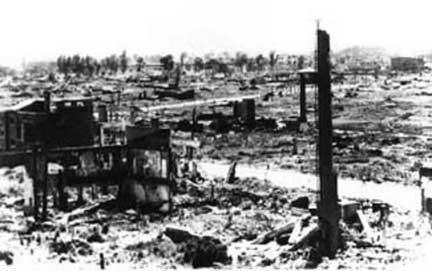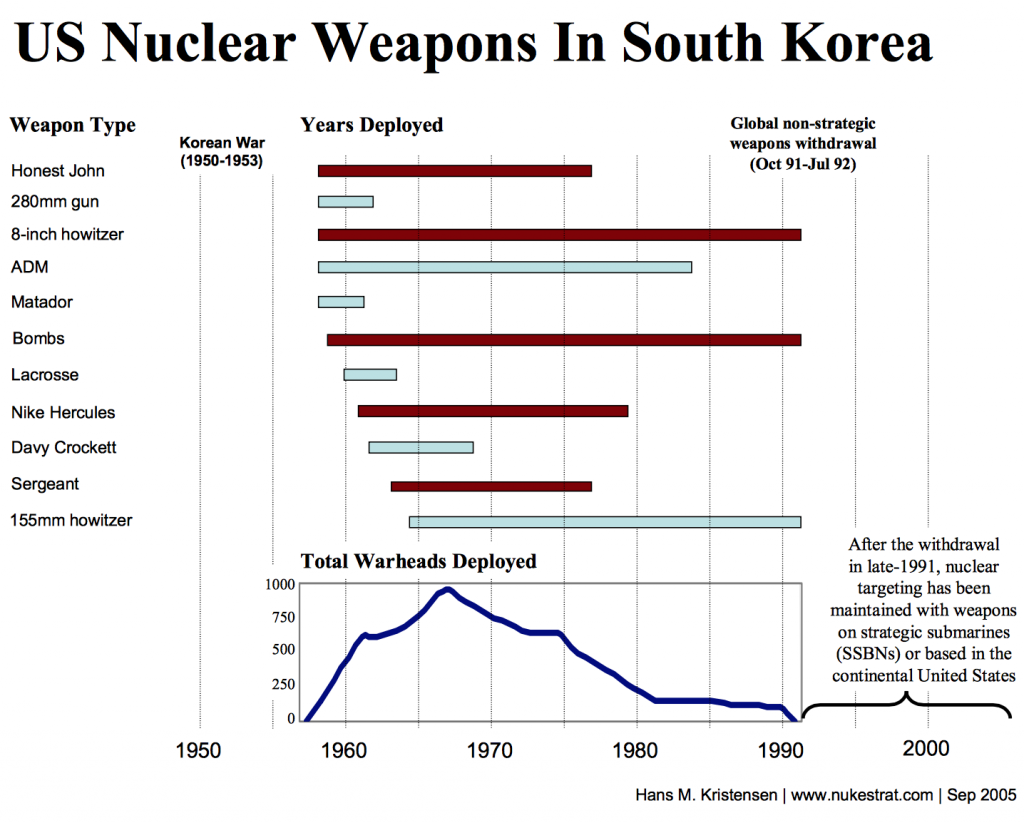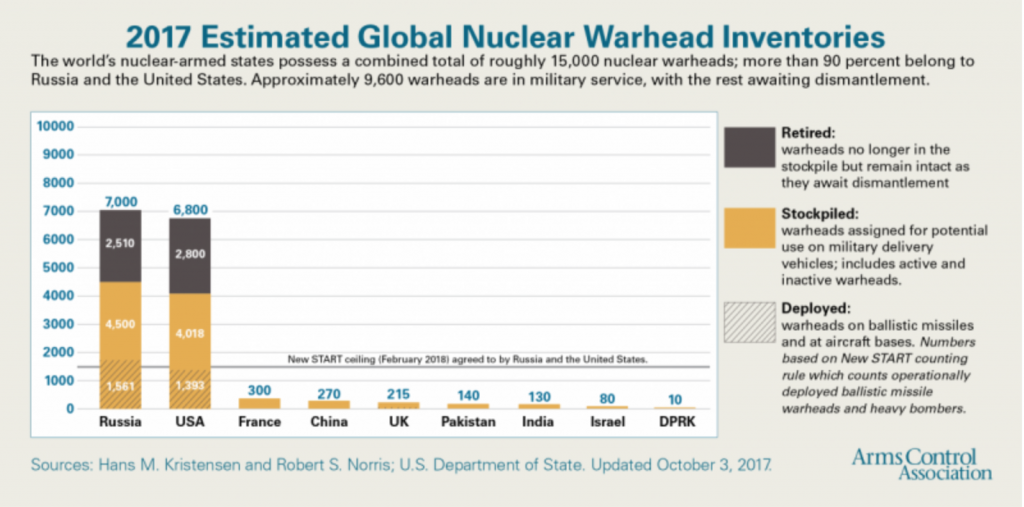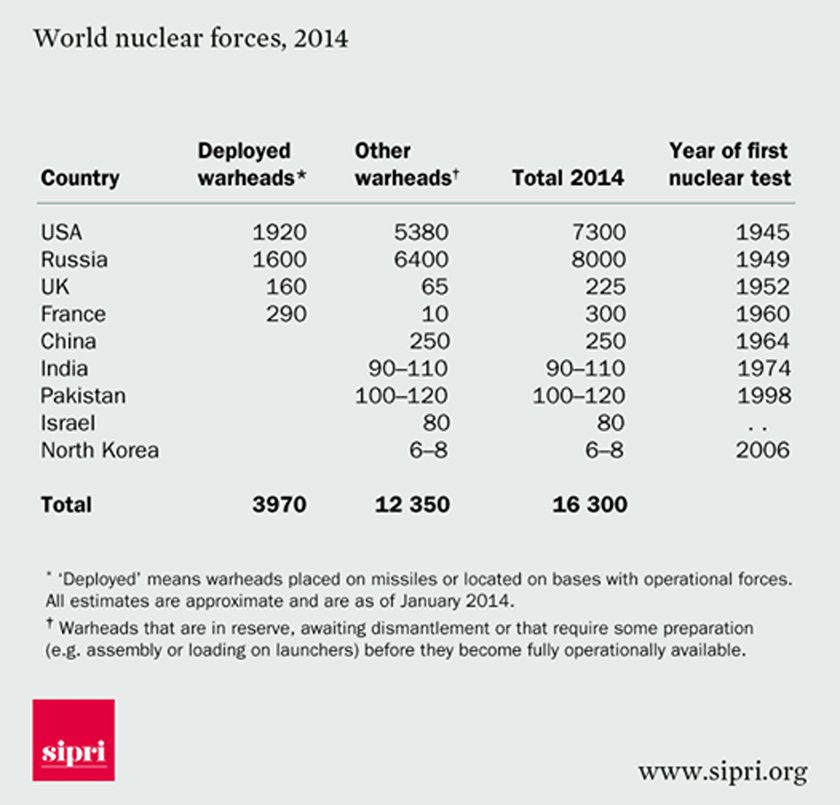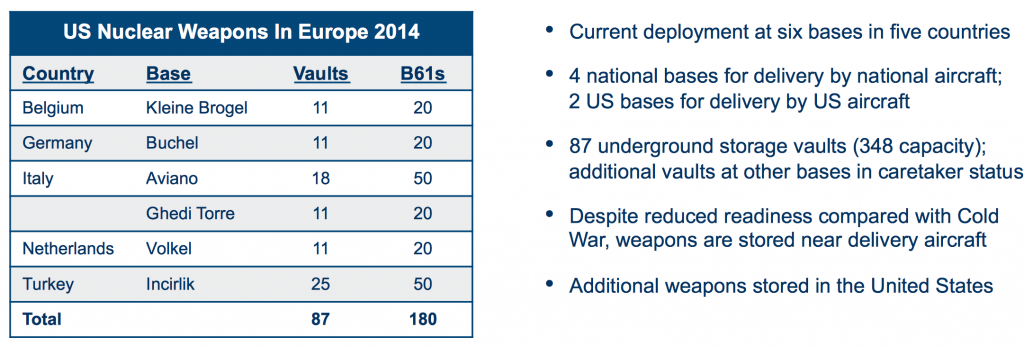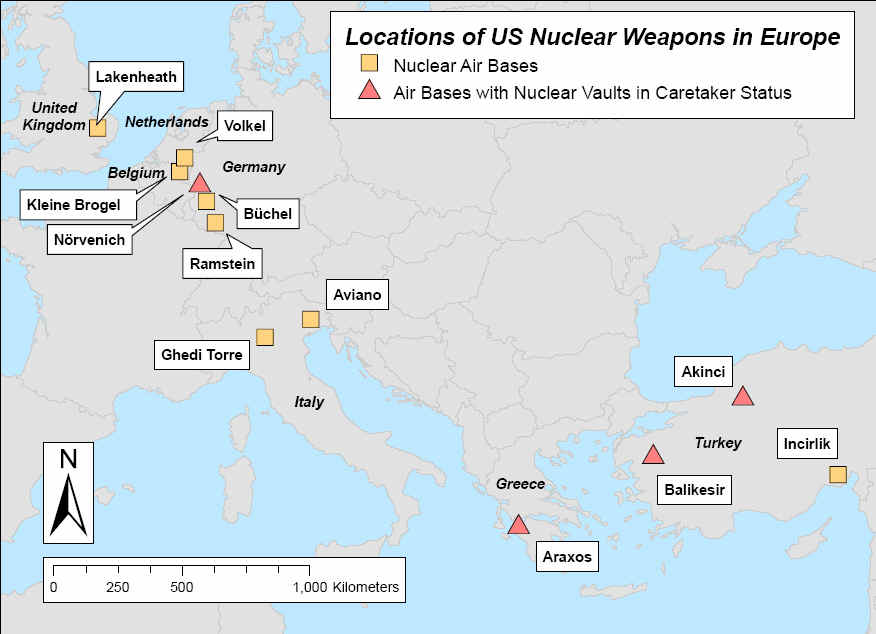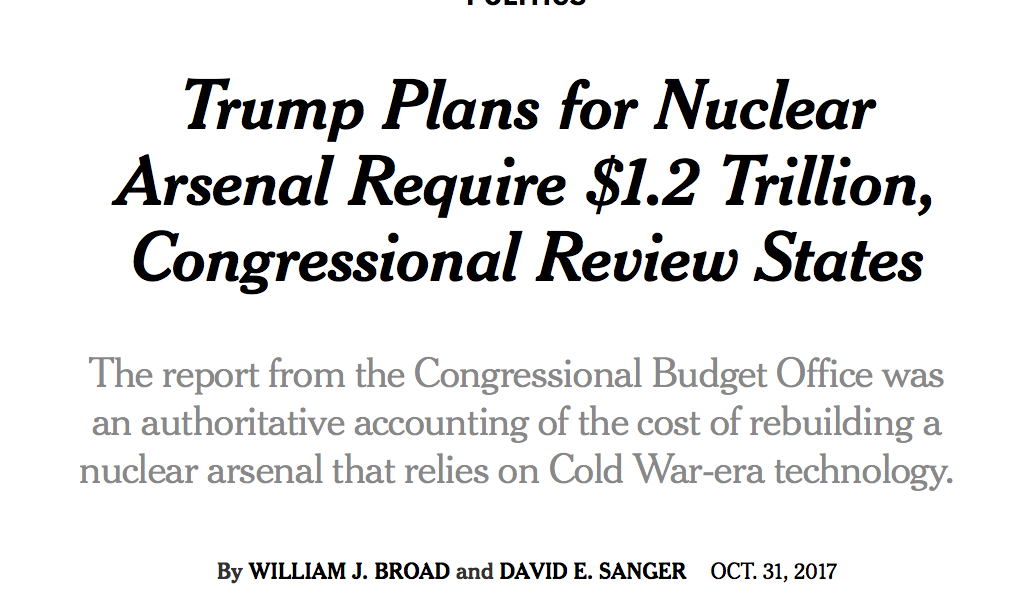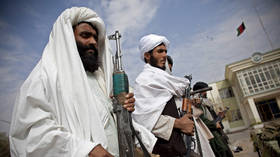The Threat of Nuclear War. North Korea or the United States?
The Threat of Nuclear War.
North Korea or the United States
by Michel Chossudovsky
Fire and Fury” was not invented by Donald Trump. It is a concept deeply embedded in US military doctrine. It has characterized US military interventions since the end of World War II.
What distinguishes Trump from his predecessors in the White House is his political narrative at the 2017 United Nations General Assembly.
We are nonetheless at a dangerous crossroads. Foreign policy miscalculation could lead to the unthinkable. We recall the circumstances of the Cuban Missile Crisis, fifty-five years ago in October 1962.
What distinguishes October 1962 to today’s realities is that the leaders on both sides, namely John F. Kennedy and Nikita S. Khrushchev were accutely aware of the dangers of nuclear annihilation.
In contrast, president Donald Trump is misinformed regarding the dangers of nuclear war, “We will have no choice but to totally destroy North Korea” accusing Kim Jong-un, of being a “rocket man” on “a suicide mission.”
Bear in mind that “MISTAKES” are often what determine the course of World History. A Pre-emptive first strike US nuclear attack against North Korea could potentially precipitate a Third World War.
While the Western media portrays North Korea’s nuclear weapons program as a threat to Global Security, it fails to acknowledge that the US has being threatening North Korea with a nuclear attack for more than half a century.
The History of “Fire and Fury”
Confirmed by US military documents, both the People’s Republic of China and the Democratic People’s Republic of Korea have been threatened with nuclear war for sixty-seven years.
President Harry Truman from the very outset of the Korean War (1950-53) was a firm advocate of “Fire and Fury” against the people of both North and South Korea. General Douglas MacArthur, who had actually carried out the atrocities directed against the Korean people appeared before the US Congress and:
“spoke of human suffering so horrifying that his parting glimpse of it caused him to vomit”.
“I have never seen such devastation,” the general told members of the Senate Armed Services and Foreign Relations committees. At that time, in May 1951, the Korean War was less than a year old. Casualties, he estimated, were already north of 1 million.
“I have seen, I guess, as much blood and disaster as any living man,” he added, “and it just curdled my stomach.” (quoted by the Washington Post, August 10, 2017)
Does the DPRK Constitute a Security Threat to the USA?
The American people should, in the words of Vietnam War Veteran Brian Willson:
“…place themselves in the position of people living in targeted countries. That North Korea, a nation of 24 million people, i.e., one-twentieth the population of the U.S., many of them poor, a land slightly larger in area than the U.S. state of Pennsylvania, continues to be one of the most demonized nations and least understood, totally perplexes the Korean people.”
What most people in America do not know –and which is particularly relevant when assessing the alleged “threats” of the DPRK to World peace– is that North Korea lost thirty percent of its population as a result of US led bombings in the 1950s. US military sources confirm that 20 percent of North Korea’s population was killed off over a three period of intensive bombings:
“After destroying North Korea’s 78 cities and thousands of her villages, and killing countless numbers of her civilians, General Curtis LeMay remarked, “Over a period of three years or so we killed off – what – twenty percent of the population.”
It is now believed that the population north of the imposed 38th Parallel lost nearly a third its population of 8 – 9 million people during the 37-month long “hot” war, 1950 – 1953, perhaps an unprecedented percentage of mortality suffered by one nation due to the belligerance of another.” (quoted in Richard Rhodes, “The General and World War III,” The New Yorker, June 19, 1995, p. 53.)
Every single family in North Korea has lost a loved one in the course of the Korean War.
In comparison, during the Second World War the United Kingdom lost 0.94% of its population, France lost 1.35%, China lost 1.89% and the US lost 0.32%. During the Korean war, North Korea lost 30 % of its population.
These figures of civilian deaths in North Korea should also be compared to those compiled for Iraq by the Lancet Study (John Hopkins School of Public Health). The Lancet study estimated a total of 655,000 Iraqi civilian deaths, in the three years following the US led invasion (March 2003- June 2006).
The US never apologized for having killed 30 percent of North Korea’s population. Quite the opposite. The main thrust of US foreign policy has been to demonize the victims of US led wars.
There were no war reparations. The issue of US crimes against the people of Korea was never addressed by the international community. Nor was there is War Crimes Tribunal.
The atrocities of the Korean War set the stage for America’s war against the people of Vietnam.
For more than half a century, Washington has contributed to the political isolation and impoverishment of North Korea. Moreover, US sponsored sanctions on Pyongyang have contributed to destabilizing the country’s economy.
North Korea has been portrayed as part of an “axis of evil”. For what?
The unspoken victim of US military aggression, the DPRK is portrayed as a failed war-mongering “Rogue State”, a “State sponsor of terrorism” and a “threat to World peace”. These stylized accusations become part of a consensus, which we dare not question.
The Lie becomes the Truth. North Korea is heralded as a threat. America is not the aggressor but “the victim”.
Washington’s intent from the very outset was to destroy North Korea and demonize an entire nation. The US has also stood in the way of the reunification of North and South Korea.
People across America should put politics aside and relate to the suffering and hardships of the people of North Korea. War Veteran Brian Willson provides a moving assessment of the plight of the North Korean people:
“Everyone I talked with, dozens and dozens of folks, lost one if not many more family members during the war, especially from the continuous bombing, much of it incendiary and napalm, deliberately dropped on virtually every space in the country. “Every means of communication, every installation, factory, city, and village” was ordered bombed by General MacArthur in the fall of 1950. It never stopped until the day of the armistice on July 27, 1953. The pained memories of people are still obvious, and their anger at “America” is often expressed, though they were very welcoming and gracious to me. Ten million Korean families remain permanently separated from each other due to the military patrolled and fenced dividing line spanning 150 miles across the entire Peninsula.
Let us make it very clear here for western readers. North Korea was virtually totally destroyed during the “Korean War.” U.S. General Douglas MacArthur’s architect for the criminal air campaign was Strategic Air Command head General Curtis LeMay who had proudly conducted the earlier March 10 – August 15, 1945 continuous incendiary bombings of Japan that had destroyed 63 major cities and murdered a million citizens. (The deadly Atomic bombings actually killed far fewer people.).Eight years later, after destroying North Korea’s 78 cities and thousands of her villages, and killing countless numbers of her civilians, LeMay remarked, “Over a period of three years or so we killed off – what – twenty percent of the population.” It is now believed that the population north of the imposed 38th Parallel lost nearly a third its population of 8 – 9 million people during the 37-month long “hot” war, 1950 – 1953, perhaps an unprecedented percentage of mortality suffered by one nation due to the belligerance of another.
Virtually every person wanted to know what I thought of Bush’s recent accusation of North Korea as part of an “axis of evil.” I shared with them my own outrage and fears, and they seemed relieved to know that not all “Americans” are so cruel and bellicose. As with people in so many other nations with whom the U.S. has treated with hostility, they simply cannot understand why the U.S. is so obsessed with them.”(Brian Willson, Korea and the Axis of Evil, Global Research, October 12, 2006 emphasis added)
Pyongyang 1953
The Nature of US Atrocities against the People of Korea
The DPRK’s Foreign Minister’s Cable to the United Nations Security Council confirmed the nature of the atrocities committed by the US against the people of North Korea, acting under the banner of the United Nations:
See original below.
“ON JANUARY 3 AT 10:30 AM, AN ARMADE OF 82 FLYING FORTRESSES LOOSED THEIR DEATH-DEALING LOAD ON THE CITY OF PYONGYANG. …
HUNDREDS OF TONS OF BOMBS AND INCENDIARY COMPOUND WERE SIMULTANEOUSLY DROPPED THROUGHOUT THE CITY, CAUSING ANNIHILATING FIRES. IN ORDER TO PREVENT THE EXTINCTION OF THESE FIRES, THE TRANS-ATLANTIC BARBARIANS BOMBED THE CITY WITH DELAYED-ACTION HIGH-EXPLOSIVE BOMBS WHICH EXPLODED AT INTERVALS THROUGHOUT FOR A WHOLE DAY, MAKING IT IMPOSSIBLE FOR THE PEOPLE TO COME OUT ONTO THE STREETS. THE ENTIRE CITY HAS NOW BEEN BURNING, ENVELOPED IN FLAMES, FOR TWO DAYS. BY THE SECOND DAY 7,812 CIVILIANS’ HOUSES HAD BEEN BURNT DOWN. THE AMERICANS WERE WELL AWARE THAT THERE WERE NO MILITARY OBJECTIVES LEFT IN PYONGYANG. …
THE NUMBER OF INHABITANTS OF PYONGYANG KILLED BY BOMB SPLINTERS, BURNT ALIVE AND SUFFOCATED BY SMOKE IS INCALCULABLE, SINCE NO COMPUTATION IS POSSIBLE. SOME FIFTY THOUSAND INHABITANTS REMAIN IN THE CITY, WHICH BEFORE THE WAR HAD A POPULATION OF FIVE HUNDRED THOUSAND.”
It was all for a good cause: the fight against “evil communism”. The doctrine of fighting communism acted as a powerful ideological instrument during the Cold War era.
Our message to US military servicemen and women at all levels of the military hierarchy.
Reverse the course of History. Abandon the Battle Field, Refuse to Fight!
For complete text of the cable addressed to the UN Security Council click UN Repository
EXCERPTS FROM VIDEO
The “Hiroshima Doctrine” applied to North Korea
 US nuclear doctrine pertaining to Korea was established following the bombings of Hiroshima and Nagasaki in August 1945, which were largely directed against civilians.
US nuclear doctrine pertaining to Korea was established following the bombings of Hiroshima and Nagasaki in August 1945, which were largely directed against civilians.
The strategic objective of a nuclear attack under the “Hiroshima doctrine” was to trigger a “massive casualty producing event”resulting in tens of thousands of deaths. The objective was to terrorize an entire nation, as a means of military conquest. Military targets were not the main objective: the notion of “collateral damage” was used as a justification for the mass killing of civilians, under the official pretence that Hiroshima was “a military base” and that civilians were not the target.
In the words of President Harry Truman:
“We have discovered the most terrible bomb in the history of the world. … This weapon is to be used against Japan … [We] will use it so that military objectives and soldiers and sailors are the target and not women and children. Even if the Japs are savages, ruthless, merciless and fanatic, we as the leader of the world for the common welfare cannot drop that terrible bomb on the old capital or the new. … The target will be a purely military one… It seems to be the most terrible thing ever discovered, but it can be made the most useful.” (President Harry S. Truman, Diary, July 25, 1945)
“The World will note that the first atomic bomb was dropped on Hiroshima a military base. That was because we wished in this first attack to avoid, insofar as possible, the killing of civilians..”(President Harry S. Truman in a radio speech to the Nation, August 9, 1945). (audio available)
[Note: the first atomic bomb was dropped on Hiroshima on August 6, 1945; the Second on Nagasaki, on August 9, on the same day as Truman’s radio speech to the Nation]
http://orwell.ru/library/articles/ABomb/truman.au
Related audio:
https://www.c-span.org/video/?294914-1/president-truman-speech-bombing-hiroshima
Nobody within the upper echelons of the US government and military believed that Hiroshima was a military base, Truman was lying to himself and to the American public. To this day the use of nuclear weapons against Japan is justified as a necessary cost for bringing the war to an end and ultimately “saving lives”.
The US Nuclear Threat against North Korea Started in 1950
In 1950, Chinese volunteer forces dispatched by the People’s Republic of China were firmly behind North Korea against US aggression.
China’s act of solidarity with The Democratic People’s Republic of Korea (DPRK) was carried out barely a few months after the founding of the PRC on October 1, 1949.
Truman had contemplated the use of nuclear weapons against both China and North Korea, specifically as a means to repeal the Chinese Volunteer People’s Army (VPA) which had been dispatched to fight alongside North Korean forces. [Chinese Volunteer People’s Army, 中國人民志願軍; Zhōngguó Rénmín Zhìyuàn Jūn].
It is important to stress that US military action directed against the DPRK was part of a broader Cold War military agenda against the PRC and the Soviet Union, the objective of which was ultimately to undermine and destroy socialism.
US Nuclear Weapons Stockpiled and Deployed in South Korea (1958-1991)
Barely a few years after the end of the Korean War, the US initiated its deployment of nuclear warheads in South Korea. This deployment in Uijongbu and Anyang-Ni had been envisaged as early as 1956.
It is worth noting that the US decision to bring nuclear warheads to South Korea was in blatant violation of Paragraph 13(d) of the Armistice Agreement which prohibited the warring factions from introducing new weapons into Korea.
The actual deployment of nuclear warheads started in January 1958, four and a half years after the end of the Korean War, “with the introduction of five nuclear weapon systems: the Honest John surface-to-surface missile, the Matador cruise missile, the Atomic-Demolition Munition (ADM) nuclear landmine, and the 280-mm gun and 8-inch (203mm) howitzer.” (See The nuclear information project: US Nuclear Weapons in Korea)
The Davy Crockett projectile was deployed in South Korea between July 1962 and June 1968. The warhead had selective yields up to 0.25 kilotons. The projectile weighed only 34.5 kg (76 lbs). Nuclear bombs for fighter bombers arrived in March 1958, followed by three surface-to-surface missile systems (Lacrosse, Davy Crockett, and Sergeant) between July 1960 and September 1963. The dual-mission Nike Hercules anti-air and surface-to-surface missile arrived in January 1961, and finally the 155-mm Howitzer arrived in October 1964. At the peak of this build-up, nearly 950 warheads were deployed in South Korea.
Four of the weapon types only remained deployed for a few years, while the others stayed for decades. The 8-inch Howitzer stayed until late 1991, the only weapon to be deployed throughout the entire 33-year period of U.S. nuclear weapons deployment to South Korea. The other weapons that stayed till the end were the air delivered bombs (several different bomb types were deployed over the years, ending with the B61) and the 155-mm Howitzer nuclear artillery. (Nuclear Information Project, op. cit)
Officially the US deployment of nuclear weapons in South Korea lasted for 33 years. The deployment was targeted against North Korea as well as China and the Soviet Union.
South Korea’s Nuclear Weapons Program
Concurrent and in coordination with the US deployment of nuclear warheads in South Korea, the ROK had initiated its own nuclear weapons program in the early 1970s.
The official story is that the US exerted pressure on Seoul to abandon their nuclear weapons program and “sign the Treaty on the Non-Proliferation of Nuclear Weapons (NPT) in April 1975 before it had produced any fissile material.” (Daniel A. Pinkston, “South Korea’s Nuclear Experiments,” CNS Research Story, 9 November 2004, http://cns.miis.edu.]
The ROK’s nuclear initiative was from the outset in the early 1970s under the supervision of the US and was developed as a component part of the US deployment of nuclear weapons, with a view to threatening North Korea.
Double Standards: While the West in chorus accuses the DPRK of developing nuclear capabilities, the development of a nuclear weapons program in South Korea was never an issue. Neither was the ROK designated as an undeclared nuclear weapons state.
Moreover, while this program was officially ended in 1978, the US promoted scientific expertise as well as training of the ROK military in the use of nuclear weapons. And bear in mind: under the ROK-US CFC agreement, all operational units of the ROK are under joint command headed by a US General. This means that all the military facilities and bases established by the Korean military are de facto joint facilities. There are a total of 27 US military facilities in the ROK (See List of United States Army installations in South Korea – Wikipedia)
[As of 1978] Nuclear Attacks against North Korea were planned from the Continental US and from Strategic US Submarines
According to military sources, the removal of US nuclear weapons from South Korea was initiated in the mid 1970s. It was completed in 1991:
The nuclear weapons storage site at Osan Air base was deactivated in late 1977. This reduction continued over the following years and resulted in the number of nuclear weapons in South Korea dropping from some 540 in 1976 to approximately 150 artillery shells and bombs in 1985. By the time of the Presidential Nuclear Initiative in 1991, roughly 100 warheads remained, all of which had been withdrawn by December 1991. (The nuclear information project: withdrawal of US nuclear weapons from South Korea)
According to official statements, the US withdrew its nuclear weapons from South Korea in December 1991.
This withdrawal from Korea did not in any way modify the US threat of nuclear war directed against the DPRK. On the contrary: it was tied to changes in US military strategy with regard to the deployment of nuclear warheads. Major North Korean cities were to be targeted with nuclear warheads from US continental locations and from US strategic submarines (SSBN) rather than military facilities in South Korea:
After the withdrawal of [US] nuclear weapons from South Korea in December 1991, the 4th Fighter Wing at Seymour Johnson Air Force Base has been tasked with nuclear strike planning against North Korea. Since then, strike planning against North Korea with non-strategic nuclear weapons has been the responsibility of fighter wings based in the continental United States. One of these is the 4th Fighter Wing at Seymour Johnson Air Force Base in North Carolina. …
“We simulated fighting a war in Korea, using a Korean scenario. … The scenario…simulated a decision by the National Command Authority about considering using nuclear weapons….We identified aircraft, crews, and [weapon] loaders to load up tactical nuclear weapons onto our aircraft….
With a capability to strike targets in less than 15 minutes, the Trident D5 sea-launched ballistic missile is a “mission critical system” for U.S. Forces Korea. Ballistic Missile Submarines and Long-Range Bombers
In addition to non-strategic air delivered bombs, sea-launched ballistic missiles onboard strategic Ohio-class submarines (SSBNs) patrolling in the Pacific appear also to have a mission against North Korea. A DOD General Inspector report from 1998 listed the Trident system as a “mission critical system” identified by U.S. Pacific Command and U.S. Forces Korea as “being of particular importance to them.”
Although the primary mission of the Trident system is directed against targets in Russia and China, a D5 missile launched in a low-trajectory flight provides a unique very short notice (12-13 minutes) strike capability against time-critical targets in North Korea. No other U.S. nuclear weapon system can get a warhead on target that fast. Two-three SSBNs are on “hard alert” in the Pacific at any given time, holding Russian, Chinese and North Korean targets at risk from designated patrol areas.
Long-range strategic bombers may also be assigned a nuclear strike role against North Korea although little specific is known. An Air Force map suggests a B-2 strike role against North Korea. As the designated carrier of the B61-11 earth penetrating nuclear bomb, the B-2 is a strong candidate for potential nuclear strike missions against North Korean deeply buried underground facilities.
As the designated carrier of the B61-11 earth penetrating nuclear bomb [with an explosive capacity between one third and six times a Hiroshima bomb] and a possible future Robust Nuclear Earth Penetrator, the B-2 stealth bomber could have an important role against targets in North Korea. Recent upgrades enable planning of a new B-2 nuclear strike mission in less than 8 hours. (The nuclear information project: withdrawal of US nuclear weapons from South Korea, emphasis added))
[Under the Bush Junior], Pre-emptive Nuclear War [was envisaged against North Korea] as an Instrument of “Self-Defense”
The Bush Administration’s 2001 Nuclear Posture Review
The Bush administration in its 2001 Nuclear Posture Review established the contours of a new post 9/11 “pre-emptive” nuclear war doctrine, namely that nuclear weapons could be used as an instrument of “self-defense” against non-nuclear states
“Requirements for U.S. nuclear strike capabilities” directed against North Korea were established as part of a Global Strike mission under the helm of US Strategic Command Headquarters in Omaha Nebraska, the so-called CONPLAN 8022, which was directed against a number of “rogue states” including North Korea as well as Iran, China and Russia.
On November 18, 2005, the new Space and Global Strike command became operational at STRATCOM after passing testing in a nuclear war exercise involving North Korea.
Current U.S. Nuclear strike planning against North Korea appears to serve three roles: The first is a vaguely defined traditional deterrence role intended to influence North Korean behavior prior to hostilities.
This role was broadened somewhat by the 2001 Nuclear Posture Review to not only deter but also dissuade North Korea from pursuing weapons of mass destruction.
Why, after five decades of confronting North Korea with nuclear weapons, the Bush administration believes that additional nuclear capabilities will somehow dissuade North Korea from pursuing weapons of mass destruction [nuclear weapons program] is a mystery. (Ibid, emphasis added)
Asymmetry of Nuclear Capabilities?
The asymmetry of nuclear weapons capabilities between the US and the DPRK must be emphasised. According to ArmsControl.org (April 2013) the United States:
“possesses 5,113 nuclear warheads, including tactical, strategic, and non-deployed weapons.”
According to the latest official New START declaration, out of more than 5113 nuclear weapons,
“the US deploys 1,654 strategic nuclear warheads on 792 deployed ICBMs, SLBMs, and strategic bombers…”ArmsControl.org (April 2013).
The latest estimates place the DPRK’s nuclear capabilities at 1o nuclear warheads.
Source: www.Sipri.org
Moreover, according to The Federation of American Scientists the U.S. possesses 500 tactical nuclear warheads. (ArmsControl.org April 2013). [which are slated to be used against North Korea]
The tables above, however, do not include the nuclear capabilities of Five Undeclared Nuclear Weapons States: Belgium, Netherlands, Germany, Italy, Turkey, which possess and deploy 150 B61 tactical nuclear weapons, weapons are directed against Russia, Iran and countries in the Middle East.
While the nuclear warheads are made in America, they are entirely under national command.
Nobody seems to be concerned and the issue is not an object of media coverage. Belgium is reported to have 20 B61 nuclear weapons under national command, Turkey has 50.
Source: Hans M. Kristensen, Federation of American Scientists,
presentation to Dutch and Belgian parliamentary committees , 2014
Double standards. No Trump “Fire and Fury” directed against the Netherlands and Belgium, which together possess 40 nuclear weapons under national command. Compare that to the DPRK’s 10 nuclear weapons, heralded as a “threat” to the security of the Western World.
The Democratic People’s Republic of Korea, the unspoken victim of US military aggression, has been incessantly portrayed as a war mongering nation, a menace to the American Homeland and a “threat to World peace”. These stylized accusations have become part of a media consensus.
The threat of nuclear war does not emanate from the DPRK but from the US and its allies. Meanwhile, Washington is now implementing a $32 billion refurbishing of strategic nuclear weapons as well as a revamping of its tactical nuclear weapons, which according to a 2002 Senate decision “are harmless to the surrounding civilian population because the explosion is underground.” according to scientists on contract to the Pentagon.
These continuous threats and actions of latent aggression directed against the DPRK should also be understood as part of the broader US military agenda in East Asia, directed against China and Russia.
It is important that people across the land, in the US, Western countries, come to realize that the United States rather than North Korea or Iran is a threat to global security.
Political Insanity and Nuclear War
Insanity in US foreign policy, not to mention the fiction that nuclear weapons are an “instrument of peace” could lead to the unthinkable.
A One Trillion dollar nuclear weapons program was launched under the Obama administration.
Trump wisely pushed it to $1.2 Trillion:
Screenshot of New York Times
Towards a Peace Solution
The 1953 Armistice Agreement
The US is still at war with North Korea. The armistice agreement signed in July 1953 –which legally constitutes a “temporary ceasefire” between the warring parties (US, North Korea and China’s Volunteer Army)– must be rescinded through the signing of a long-lasting peace agreement.
What underlies the 1953 Armistice Agreement is that one of the warring parties, namely the US has consistently threatened to wage war on the DPRK for more than 60 years.
The US has not only violated the armistice agreement, it has consistently refused to enter into peace negotiations with Pyongyang, with a view to maintaining its military presence in South Korea as well as shunting a process of normalization and cooperation between the ROK and the DPRK.
The US was involved in the de facto abrogation of paragraph 13(d) of the Armistice agreement, which forecloses the parties from entering new weapons into Korea. In 1956, Washington brought in and installed nuclear weapons facilities into South Korea. In so doing, the U.S. not only abrogated paragraph 13(d), it abrogated the entire Armistice agreement through the deployment of US troops and weapons systems in the ROK.
More recently the US has deployed the so-called THAAD missiles (also in abrogation of the Armistice agreement). The THAAD missiles are largely directed against China and Russia.
Michel Chossudovsky’s keynote address at the 60th anniversary commemoration of the end of the Korean war, Seoul, South Korea, July 26, 2013
Towards a Bilateral North-South Peace Agreement
If one of the signatories of the Armistice agreement refuses to sign a Peace Agreement, (and this is the situaiton which currently prevails) what should be contemplated is the formulation of a comprehensive Bilateral North-South Peace Agreement, which would de facto lead to rescinding the 1953 armistice agreement.
What should be sought is that the “state of war” between the US and the DPRK (which prevails under the armistice agreement) be in a sense “side-tracked” and annulled by the signing of a comprehensive bilateral North-South peace agreement, coupled with cooperation and interchange.
This proposed far-reaching agreement between Seoul and Pyongyang would assert peace on the Korean peninsula –failing the signing of a peace agreement between the signatories of the 1953 Armistice agreement.
The legal formulation of this bilateral entente is crucial. The bilateral arrangement would in effect bypass Washington’s refusal. It would establish the basis of peace on the Korean peninsula, without foreign intervention, namely without Washington dictating its conditions.
It would require the concurrent withdrawal of US troops from the ROK and the repeal of the Operational Control (OPCON) agreement.
As we recall, in 1978 a binational Republic of Korea – United States Combined Forces Command (CFC), was created under the presidency of General Park (military dictator and father of impeached president Park Guen-hye). In substance, this was a change in labels in relation to the so-called UN Command.
“Ever since the Korean War, the allies have agreed that the American four-star would be in “Operational Control” (OPCON) of both ROK and US military forces in wartime …. Before 1978, this was accomplished through the United Nations Command. Since then it has been the CFC [US Combined Forces Command (CFC) structure]. (Brookings Institute)
Moreover, the Command of the US General under the renegotiated OPCON (2014) remains fully operational inasmuch as the 1953 Armistice (which legally constitutes a temporary ceasefire) is not replaced by a peace treaty.
Moreover, it should be noted that the militarization of the ROK under the OPCOM agreement, including the development of new military bases, is also largely intent upon using the Korean peninsula as a military launchpad threatening both China and Russia. Under OPCOM, “in the case of war”, the entire force of the ROK would be mobilized under US command against China or Russia.
It goes without saying that national sovereignty cannot reasonably be achieved without the annulment of the OPCON agreement as well as the ROK – US Combined Forces Command (CFC) structure.

